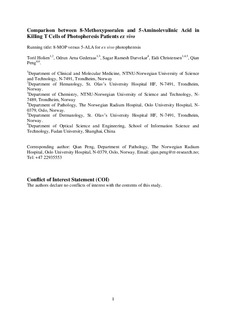| dc.contributor.author | Holien, Toril | |
| dc.contributor.author | Gederaas, Odrun Arna | |
| dc.contributor.author | Darvekar, Sagar | |
| dc.contributor.author | Christensen, Eidi | |
| dc.contributor.author | Qian, Peng | |
| dc.date.accessioned | 2019-03-05T12:45:37Z | |
| dc.date.available | 2019-03-05T12:45:37Z | |
| dc.date.created | 2018-06-20T08:56:22Z | |
| dc.date.issued | 2018 | |
| dc.identifier.citation | Lasers in Surgery and Medicine. 2018, 50 (5), 469-475. | nb_NO |
| dc.identifier.issn | 0196-8092 | |
| dc.identifier.uri | http://hdl.handle.net/11250/2588779 | |
| dc.description.abstract | Background and Objective
Extracorporeal photopheresis (ECP), an established modality for cutaneous T‐cell lymphoma (CTCL) and graft‐versus‐host disease, involves ex vivo treatment of isolated leukocytes of a patient with the photosensitizing drug 8‐methoxypsoralen (8‐MOP) and ultraviolet‐A (UV‐A) exposure before reinfusion back to the patient. However, 8‐MOP binds to both diseased and normal cells and thus kills both types of the cells after UV‐A illumination with little selectivity. Clinically, this modality gives only partial response in the majority of treated patients. 5‐Aminolevulinic acid (5‐ALA), a precursor of the potent photosensitizer protoporphyrin IX (PpIX), has been shown to selectively induce PpIX in activated T lymphocytes (T cells) and could be an alternative for 8‐MOP. The objectives of this study were to investigate ex vivo 5‐ALA dark toxicity, 5‐ALA‐induced PpIX production, and photodynamic effect on T cells obtained from clinical ECP patients after the treatment of 5‐ALA or 8‐MOP plus a built‐in certified UV‐A source in the commercial Therakos™ Photopheresis System.
Materials and Methods
Flow cytometry was used to study dark cytotoxic effects of 5‐ALA on human leukocytes, to measure the production of 5‐ALA‐induced PpIX in CD25+ activated T cells from both diluted mononuclear cells and undiluted buffy coat samples of ECP patients and to compare photodynamic effects on CD4+ and CD8+ T cells with 5‐ALA/UV‐A or 8‐MOP/UV‐A.
Results
No dark toxicity of 5‐ALA on the leukocytes of ECP patients was seen at concentrations up to 10 mM for an incubation of up to 20 hours. 5‐ALA‐induced PpIX was produced more in CD25+ activated T cells than resting T cells in both diluted mononuclear cells and undiluted buffy coat samples, although there was a huge variation of samples from different individual patients. The CD4+ and CD8+ T cells treated with 5‐ALA/UV‐A were killed more than those treated with 8‐MOP/UV‐A.
Conclusion
These results suggest that 5‐ALA/UV‐A may have the potential for improving the efficacy of ECP. Lasers Surg. Med. 50:469–475, 2018. | nb_NO |
| dc.language.iso | eng | nb_NO |
| dc.publisher | Wiley | nb_NO |
| dc.title | Comparison Between 8-Methoxypsoralen and 5-Aminolevulinic Acid in Killing T Cells of Photopheresis Patients Ex Vivo | nb_NO |
| dc.type | Journal article | nb_NO |
| dc.type | Peer reviewed | nb_NO |
| dc.description.version | acceptedVersion | nb_NO |
| dc.source.pagenumber | 469-475 | nb_NO |
| dc.source.volume | 50 | nb_NO |
| dc.source.journal | Lasers in Surgery and Medicine | nb_NO |
| dc.source.issue | 5 | nb_NO |
| dc.identifier.doi | 10.1002/lsm.22806 | |
| dc.identifier.cristin | 1592479 | |
| dc.description.localcode | This is the peer reviewed version of an article, which has been published in final form at [https://doi.org/10.1002/lsm.22806]. This article may be used for non-commercial purposes in accordance with Wiley Terms and Conditions for Self-Archiving. | nb_NO |
| cristin.unitcode | 194,65,15,0 | |
| cristin.unitcode | 194,66,25,0 | |
| cristin.unitname | Institutt for klinisk og molekylær medisin | |
| cristin.unitname | Institutt for kjemi | |
| cristin.ispublished | true | |
| cristin.fulltext | postprint | |
| cristin.qualitycode | 2 | |
